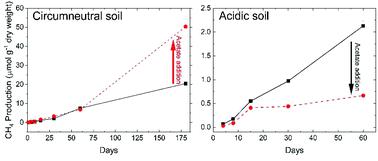当前位置:
X-MOL 学术
›
Environ. Sci.: Processes Impacts
›
论文详情
Our official English website, www.x-mol.net, welcomes your feedback! (Note: you will need to create a separate account there.)
Anaerobic respiration pathways and response to increased substrate availability of Arctic wetland soils
Environmental Science: Processes & Impacts ( IF 5.5 ) Pub Date : 2020-08-28 , DOI: 10.1039/d0em00124d Michael Philben 1, 2, 3, 4 , Lijie Zhang 1, 2, 3, 4 , Ziming Yang 4, 5, 6 , Neslihan Taş 4, 7, 8 , Stan D. Wullschleger 1, 2, 3, 4 , David E. Graham 2, 3, 4, 9 , Baohua Gu 1, 2, 3, 4
Environmental Science: Processes & Impacts ( IF 5.5 ) Pub Date : 2020-08-28 , DOI: 10.1039/d0em00124d Michael Philben 1, 2, 3, 4 , Lijie Zhang 1, 2, 3, 4 , Ziming Yang 4, 5, 6 , Neslihan Taş 4, 7, 8 , Stan D. Wullschleger 1, 2, 3, 4 , David E. Graham 2, 3, 4, 9 , Baohua Gu 1, 2, 3, 4
Affiliation

|
The availability of labile carbon (C) compounds in Arctic wetland soils is expected to increase due to thawing permafrost and increased fermentation as a result of decomposition of organic matter with warming. How microbial communities respond to this change will affect the balance of CO2 and CH4 emitted during anaerobic organic matter decomposition, and ultimately the net radiative forcing of greenhouse gas emissions from these soils. While soil water content limits aerobic respiration, the factors controlling methanogenesis and anaerobic respiration are poorly defined in suboxic Arctic soils. We conducted incubation experiments on two tundra soils from field sites on the Seward Peninsula, Alaska, with contrasting pH and geochemistry to determine the pathways of anaerobic microbial respiration and changes with increasing substrate availability upon warming. In incubation of soils from the circumneutral Teller site, the ratio of CO2 to CH4 dropped from 10 to <2 after 60 days, indicating rapid depletion of alternative terminal electron acceptors (TEAs). Addition of acetate stimulated production of CO2 and CH4 in a nearly 1 : 1 ratio, consistent with methanogenesis, and the composition of the microbial community shifted to favor clades capable of utilizing the added acetate such as the Fe(III)-reducing Geobacter and the methanogenic archaea Methanosarcina. In contrast, both CO2 and CH4 production declined with acetate addition during incubation of soils from the more acidic Council site, and fermentative microorganisms increased in abundance despite the high availability of fermentation products. These results demonstrate that the degree to which increasing substrate availability stimulates greenhouse gas production in tundra wetlands will vary widely depending on soil pH and geochemistry.
中文翻译:

厌氧呼吸途径及对北极湿地土壤底物有效性增加的响应
北极湿地土壤中不稳定碳(C)化合物的可用性预计将因永久冻土的融化和由于有机物随温度升高分解而增加的发酵而增加。微生物群落如何响应这一变化将影响CO 2和CH 4的平衡厌氧有机物分解过程中产生的温室气体排放,最终导致这些土壤温室气体排放的净辐射强迫。虽然土壤含水量限制了有氧呼吸,但是在低氧北极土壤中,控制甲烷生成和无氧呼吸的因素却定义不清。我们在来自阿拉斯加苏厄德半岛野外场所的两种苔原土壤上进行了温育实验,对比了pH和地球化学,以确定厌氧微生物呼吸的途径以及变暖后底物利用率增加的变化。在从中性泰勒场培养土壤时,CO 2与CH 4的比率在60天后从10下降到<2,表明其他末端电子受体(TEA)迅速耗尽。添加乙酸盐以接近1:1的比例刺激了CO 2和CH 4的生成,这与甲烷生成一致,并且微生物群落的组成发生了变化,有利于能够利用添加的乙酸盐的枝条,例如还原Fe(III)的土壤杆菌和产甲烷的古细菌Methanosarcina。相反,CO 2和CH 4在较酸性的市议会所在地培育土壤期间,添加乙酸盐会导致产量下降,尽管发酵产品的利用率很高,但发酵微生物却大量增加。这些结果表明,增加基质的可利用性刺激苔原湿地中温室气体产生的程度将在很大程度上取决于土壤的pH值和地球化学。
更新日期:2020-09-08
中文翻译:

厌氧呼吸途径及对北极湿地土壤底物有效性增加的响应
北极湿地土壤中不稳定碳(C)化合物的可用性预计将因永久冻土的融化和由于有机物随温度升高分解而增加的发酵而增加。微生物群落如何响应这一变化将影响CO 2和CH 4的平衡厌氧有机物分解过程中产生的温室气体排放,最终导致这些土壤温室气体排放的净辐射强迫。虽然土壤含水量限制了有氧呼吸,但是在低氧北极土壤中,控制甲烷生成和无氧呼吸的因素却定义不清。我们在来自阿拉斯加苏厄德半岛野外场所的两种苔原土壤上进行了温育实验,对比了pH和地球化学,以确定厌氧微生物呼吸的途径以及变暖后底物利用率增加的变化。在从中性泰勒场培养土壤时,CO 2与CH 4的比率在60天后从10下降到<2,表明其他末端电子受体(TEA)迅速耗尽。添加乙酸盐以接近1:1的比例刺激了CO 2和CH 4的生成,这与甲烷生成一致,并且微生物群落的组成发生了变化,有利于能够利用添加的乙酸盐的枝条,例如还原Fe(III)的土壤杆菌和产甲烷的古细菌Methanosarcina。相反,CO 2和CH 4在较酸性的市议会所在地培育土壤期间,添加乙酸盐会导致产量下降,尽管发酵产品的利用率很高,但发酵微生物却大量增加。这些结果表明,增加基质的可利用性刺激苔原湿地中温室气体产生的程度将在很大程度上取决于土壤的pH值和地球化学。



























 京公网安备 11010802027423号
京公网安备 11010802027423号